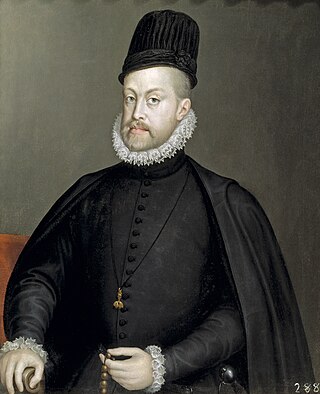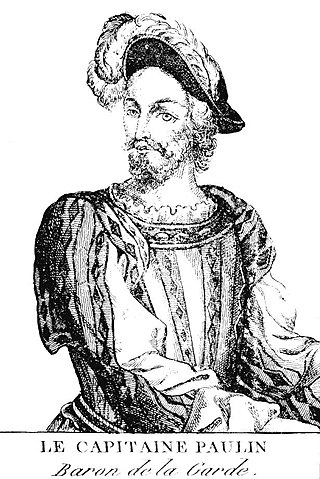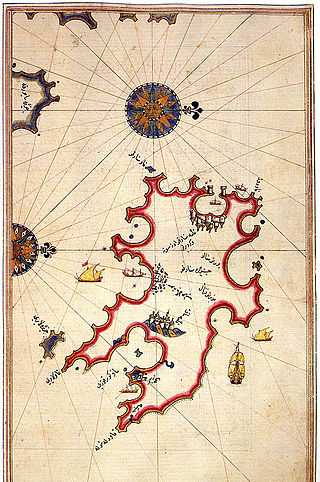
Philip II, also known as Philip the Prudent, was King of Spain from 1556, King of Portugal from 1580, and King of Naples and Sicily from 1554 until his death in 1598. He was also jure uxoris King of England and Ireland from his marriage to Queen Mary I in 1554 until her death in 1558. He was also Duke of Milan from 1540. From 1555, he was Lord of the Seventeen Provinces of the Netherlands.

The Holy League of 1571 was arranged by Pope Pius V and included the major Catholic powers of southern Europe, specifically the Spanish Empire as well as the Italian maritime powers. It was intended to break the Ottoman Empire’s control of the eastern Mediterranean Sea and was formally concluded on 25 May 1571. Its members were:

Habsburg Spain is a contemporary historiographical term referring to the huge extent of territories ruled between the 16th and the 18th centuries (1516–1700) by kings from the Spanish branch of the House of Habsburg. Habsburg Spain was a composite monarchy and a personal union. The Habsburg Spanish monarchs reached the zenith of their influence and power ruling the Spanish Empire. Spain, or "the Spains", referring to Spanish territories across different continents in this period, initially covered the entire Iberian peninsula, including the crowns of Castile, Aragon and from 1580 Portugal. It then expanded to include territories over the five continents, consisting of much of Latin America and the West Indies in the Americas, the Low Countries, Belgium, Luxembourg, Italian territories and France in Europe, Portuguese possessions such as small enclaves like Ceuta and Oran in North Africa, and the Philippines and other possessions in Southeast Asia. The period of Spanish history has also been referred to as the "Age of Expansion".

The Italian War of 1551–1559, sometimes known as the Habsburg–Valois War and the Last Italian War, began in 1551 when Henry II of France declared war against Holy Roman Emperor Charles V with the intent of recapturing parts of Italy and ensuring French, rather than Habsburg, domination of European affairs. The war ended following the signing of the Treaty of Cateau-Cambrésis between the monarchs of Spain, England and France in 1559. Historians have emphasized the importance of gunpowder technology, new styles of fortification to resist cannon fire, and the increased professionalization of the soldiers.

Piali Pasha, was an Ottoman Grand Admiral between 1553 and 1567, and a Vizier (minister) after 1568. He is also known as Piale Pasha in English.

The Fourth Ottoman–Venetian War, also known as the War of Cyprus was fought between 1570 and 1573. It was waged between the Ottoman Empire and the Republic of Venice, the latter joined by the Holy League, a coalition of Christian states formed under the auspices of the Pope, which included Spain, the Republic of Genoa, the Duchy of Savoy, the Knights Hospitaller, the Grand Duchy of Tuscany, and other Italian states.

The Franco-Ottoman Alliance, also known as the Franco-Turkish Alliance, was an alliance established in 1536 between the King of France Francis I and the Sultan of the Ottoman Empire Suleiman I. The strategic and sometimes tactical alliance was one of the longest-lasting and most important foreign alliances of France, and was particularly influential during the Italian Wars. The Franco-Ottoman military alliance reached its peak around 1553 during the reign Henry II of France.

Gabriel de Luetz, Baron et Seigneur d'Aramon et de Vallabregues, often also abbreviated to Gabriel d'Aramon, was the French Ambassador to the Ottoman Empire from 1546 to 1553, in the service first of Francis I, who dispatched him to the Ottoman Empire, and then of the French king Henry II. Gabriel de Luetz was accompanied by a vast suite of scientists, Jean de Monluc, philosopher Guillaume Postel, botanist Pierre Belon, naturalist Pierre Gilles d'Albi, the future cosmographer André Thévet, traveler Nicolas de Nicolay who would publish their findings upon their return to France and contribute greatly to the development of early science in France.

Antoine Escalin des Aimars, also known as Captain Polin or Captain Paulin, later Baron de La Garde, was French ambassador to the Ottoman Empire from 1541 to 1547, and "Général des Galères" from 1544.
François de Noailles, Papal Prothonotary, made Bishop of Dax in 1556, was French ambassador in Venice in the 1560s, and French ambassador of Charles IX to the Ottoman Empire from 1571 to 1575.

The siege of Tripoli occurred in 1551 when the Ottoman Turks and Barbary pirates besieged and vanquished the Knights of Malta in the Red Castle of Tripoli, modern Libya. The Spanish had established an outpost in Tripoli in 1510, and Charles V remitted it to the Knights in 1530. The siege culminated in a six-day bombardment and the surrender of the city on 15 August.

The Invasion of Corsica of 1553 occurred when French, Ottoman, and Corsican exile forces combined to capture the island of Corsica from the Republic of Genoa.

Paul de La Barthe de Thermes or de Termes (1482–1562), also Paul de Terme or Maréchal de Thermes, was a French Army Marshal ("Maréchal").

Jean Cavenac de la Vigne, seigneur d'Auvilliers, was French Ambassador to the Ottoman Empire from 1556 to 1566. He was the successor of Michel de Codignac, who had returned to Europe in 1558, passing through Venice in July 1558, and betrayed the French cause by entering in the service of Philip II of Spain.

An Ottoman raid of the Balearic islands was accomplished by the Ottoman Empire in 1558, against the Spanish Habsburg territory of the Balearic islands.

Turkey–Morocco relations are the foreign relations between Morocco and Turkey, and spanned a period of several centuries, from the early 16th century when the Ottoman Empire neighbored Morocco to until modern times.

Dragut, also known as "the Drawn Sword of Islam", was an Ottoman corsair, naval commander, governor, and noble. Under his command, the Ottoman Empire's maritime power was extended across North Africa. Recognized for his military genius, and as being among "the most dangerous" of corsairs, Dragut has been referred to as "the greatest pirate warrior of all time", "undoubtedly the most able of all the Turkish leaders", and "the uncrowned king of the Mediterranean". He was described by a French admiral as "a living chart of the Mediterranean, skillful enough on land to be compared to the finest generals of the time" and that "no one was more worthy than he to bear the name of king". Hayreddin Barbarossa, who was his mentor, stated that Dragut was ahead of him "both in fishing and bravery".
Giovan Giacomo Paleari Fratino (1520–1586), known as El Fratin or Il Fratino, was a military engineer who served the Spanish Emperor Charles V, and then his son Philip II of Spain. He is known for having designed the first Martello tower as well as many other fortifications.

The Treaty of Cateau-Cambrésis or Peace of Cateau-Cambrésis in April 1559 ended the Italian War of 1551–1559, the last of the Italian Wars (1494–1559). It consisted of several separate treaties, the main two signed on 2 April by Elizabeth I of England and Henry II of France, and on 3 April between Henry and Philip II of Spain. Although he was not a signatory, the agreements were approved by Emperor Ferdinand I, since many of the territorial exchanges concerned states that were part of the Holy Roman Empire.
François de Lorraine, Grand Prieur de France de l'Ordre de Malte was a French noble and soldier, who fought during the latter Italian Wars. Second youngest of the sons of Claude, Duke of Guise and Antoinette de Bourbon, the Grand Prior was selected for a life with the Order of Malta. In 1549 King Henri II appointed him Grand Prior of the Order in France, giving him access to the revenues of 'commanderies.' He fought with the king in the final years of the Italian Wars, serving in Italy in 1551 and Alsace the following year at the famous defence of Metz. He and his brother Elbeuf played a key role in the capture of Corse in 1553, defending the island against attempted counter attacks by the Genoese.

















